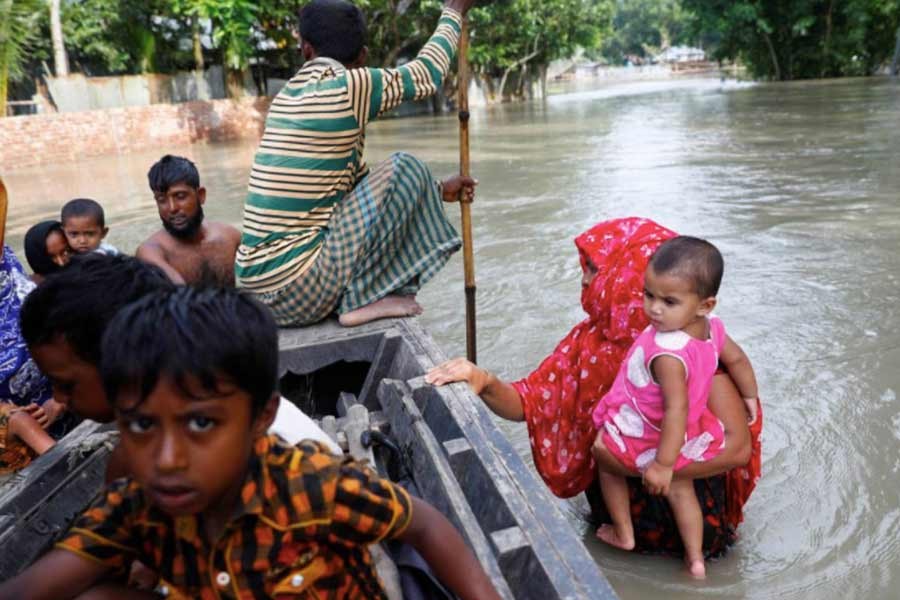Asif Ali (name changed) and his wife live with three children in a rural township bordering India and Bangladesh. Asif lost his job as a mechanic when the Covid-19 lockdown forced the closure of a small repair shop. Furthermore, the months leading into the monsoon season led to severe flooding, leaving him with a damaged home and lost livestock that had provided an additional livelihood. As the waters receded, it became a perfect breeding ground for vectors.
Unfortunately, he and his wife contracted dengue fever, with Asif in dire need of blood platelets for survival and left at the mercies of an overwhelmed health system. While the wife solicited platelet donations, the children were left to fend for themselves. With dwindling savings, food insecurity and the threat of malnutrition, the future was bleak. This scenario of cascading risks is now playing out among millions of families throughout South Asia.
This leaves us with the question - in the middle of such a pandemic, how do we address the cascading impacts of the health and disaster nexus to ensure that the development gains of the previous decade are not wiped out? To address this question, we need to understand three key fundamentals of managing interdependent and cascading risks.
THE DISASTER AND HEALTH NEXUS: Hazards and extreme events, socio-economic vulnerabilities and environmental degradation are a root cause of biological risks-accounting for 25.0 per cent of global death and disease, according to the Health and Environmental Linkages Initiative of WHO and UNEP. Disease epidemics emerge as a result of natural hazards: floods increase the risk of diarrhoeal diseases and other illnesses such as malaria, cholera and dengue. The health aspects of disaster risk are dealt more in terms of the epidemics response than addressing the root causes of the risks and associated vulnerabilities. A shift is called for in responding to these emergencies from being event-based to risk-based.
CONVERGING HOTSPOTS: The Asia-Pacific Disaster Report (2019) identifies a distinct risk hotspot, located within the trans-boundary river basins of South and South-East Asia, where poverty, hunger and under-nourishment is coupled with exposure to intensifying floods that alternate with prolonged droughts. In 2017, the WHO presented South-East Asia as a "hotspot" for emerging infectious diseases (EIDs). It records some of the highest annual incidence worldwide for diarrhoeal diseases, lower respiratory infections, malaria, measles and dengue fever. From the perspectives of hazard science and epidemiology, the converging "hotspots" of disaster risks and EIDs is quite evident.
SYSTEMIC RISKS: The Covid-19 pandemic has changed the nature and scale of risk. In our increasingly complex inter-connected world, risk has become systemic. The intersection of the Covid-19 pandemic with the disaster and health nexus is an example of the systemic risk, which requires a whole-of-government and an all-of-society approach. To enable this, it's important to construct multiple-hazard risk scenarios and associated risk matrices, including around the best approaches to risk governance in the face of systemic risk, strengthened preparedness and multi-sectoral coordination.
THE STRATEGIC PATHWAY TO THE FUTURE: The harsh spotlight of the Covid-19 pandemic has clearly demonstrated that demarcations between natural, biological and other hazards are at best arbitrary. They may have different risk transmission pathways, but they share the same geographical space and time. Several strategic efforts, including the implementation of WHO's International Health Regulations (2005) have contributed to strengthening systemic preparedness and response capacity to EIDs. However, the quality and coverage of implementation needs to be more consistent across countries.
Further, disasters are addressed in several global frameworks that are also committed to reducing pandemics and health risks. But progress has been slow. Within the Sustainable Development Goals (SDGs), SDG 3 is devoted to good health and well-being, with an emphasis on "early warning, risk reduction and management of national and global health risks." The Sendai Framework for Disaster Risk Reduction 2015-2030 (SFDRR) has a more specific focus on biological risks - driven by the experiences of Ebola, Middle East respiratory syndrome (MERS) and Severe Acute Respiratory Syndrome (SARS). The links between managing epidemics and disasters are further highlighted by the Bangkok Principles for the implementation of the health aspects of the SFDRR.
While the frameworks are available, regional cooperation is imperative in operationalisation to incorporate public health risk reduction at the heart of development and disaster policies. Shared multi-hazard risk-informed planning becomes urgent in securing a resilient future for the South Asian subregion. However, the risk of cascading disasters also offers the region an opportunity to implement cross-sectoral convergence and truly build back better. Now is the time to substantiate the often talked about 'multi-sectoral' approach and implement risk-informed decision making in all sectors. While this may be a challenge, this is also an opportunity to seize the moment to build back better a future that is resilient and includes all.
Sanjay Srivastava is Chief, Disaster Risk Reduction, United Nations Economic and Social Commission for Asia and the Pacific (UNESCAP); Madhurima Sarkar-Swaisgood is Economic Affairs Officer, UNESCAP; Edmond Fernandes is ESCAP Consultant.
[Source: https://www.unescap.org/blog]


